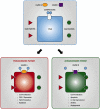Peroxisome proliferator-activated receptors and cancer: challenges and opportunities
- PMID: 21449912
- PMCID: PMC3171861
- DOI: 10.1111/j.1476-5381.2011.01383.x
Peroxisome proliferator-activated receptors and cancer: challenges and opportunities
Abstract
Peroxisome proliferator-activated receptors (PPARs), members of the nuclear hormone receptor superfamily, function as transcription factors and modulators of gene expression. These actions allow PPARs to regulate a variety of biological processes and to play a significant role in several diseases and conditions. The current literature describes frequently opposing and paradoxical roles for the three PPAR isotypes, PPARα, PPARβ/δ and PPARγ, in cancer. While some studies have implicated PPARs in the promotion and development of cancer, others, in contrast, have presented evidence for a protective role for these receptors against cancer. In some tissues, the expression level of these receptors and/or their activation correlates with a positive outcome against cancer, while, in other tissue types, their expression and activation have the opposite effect. These disparate findings raise the possibility of (i) PPAR receptor-independent effects, including effects on receptors other than PPARs by the utilized ligands; (ii) cancer stage-specific effect; and/or (iii) differences in essential ligand-related pharmacokinetic considerations. In this review, we highlight the latest available studies on the role of the various PPAR isotypes in cancer in several major organs and present challenges as well as promising opportunities in the field.
© 2011 The Authors. British Journal of Pharmacology © 2011 The British Pharmacological Society.
Figures







References
-
- Allen T, Zhang F, Moodie SA, Clemens LE, Smith A, Gregoire F, et al. Halofenate is a selective peroxisome proliferator-activated receptor gamma modulator with antidiabetic activity. Diabetes. 2006;55:2523–2533. - PubMed
-
- Anderson S, Dunn C, Cattley R, Corton JC. Hepatocellular proliferation in response to a peroxisome proliferators does not require TNFalpha signaling. Carcinogenesis. 2001;22:1843–1851. - PubMed
-
- Badawi AF, Badr MZ. Expression of cyclooxygenase-2 and peroxisome proliferators-activated receptor-gamma and levels of prostaglandin E2 and 15-deoxy-delta 12, 14-prostaglandin J2 in human breast cancer and metastasis. Int J Cancer. 2003;103:84–90. - PubMed
Publication types
MeSH terms
Substances
LinkOut - more resources
Full Text Sources
Molecular Biology Databases

